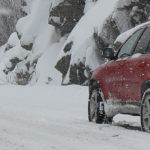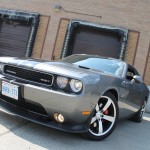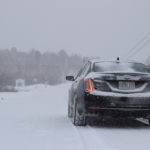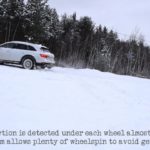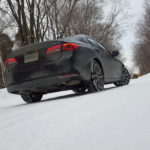Being prepared for winter driving disaster could save your life. I talk to safe driving instructor Ian Law about what to do in several gut-wrenching situations.
(Originally published via www.autos.ca)
It’s crappy stuff to think about, but sometimes, things can go horribly, horribly wrong at the wheel during winter driving. In this piece, I wanted to focus on what drivers might do in a variety of worst-case-scenario situations. We’re not talking about how to deal with a flat tire, a dead battery, or a frozen door lock here.
Like any type of machine, the vehicle you drive has countless parts that can break, fail or malfunction. Gas pedals can stick, wheels can fall off, and that thin glass windshield can be shattered faster than you can blink.
If something goes terribly wrong with your vehicle while on the move, it can leave you facing a world of potentially-fatal problems. Are you prepared for the worst at the wheel? Here’s a look at how to maximize your chances of survival, in some of the most gut-wrenching motoring situations you may face during this year’s winter driving season.
Problem: Your throttle pedal is stuck
A malfunction with your throttle keeps the pedal stuck to the floor after passing another vehicle. You start to panic, and your vehicle piles on speed dangerously.
Solution: Neutral, Now!
Forget turning off the engine or braking. The first course of action here is to slip the vehicle into neutral. Doing so takes half a second, and decouples the engine from the wheels. In neutral, your vehicle can’t accelerate– no matter how hard the throttle is pressed.
In this situation, the engine will continue to rev at maximum RPM, though the vehicle will slow. The sound of the engine revving at high speed may be intimidating, but it’s the least of your worries.
Once in neutral, signal, brake and coast off to the side of the road. Turn the engine off and assess the problem.
Practice putting your gear selector into neutral, so you’re ready if the need arises. Teach your kids, too. Note that if your car has a stick-shift, pressing and holding the clutch pedal has the same effect.
Problem: You’re driving blind
You’re travelling at highway speeds when you suddenly hear a loud noise and realize you can’t see. A piece of ice had become dislodged from the roof of a transport truck nearby, and penetrated your windshield– sending glass into your eyes. Your vehicle is now a projectile without a pilot.
Solution: Know Your Surroundings
Ian Law is race car driver and the president and chief instructor of the ILR Car Control School (www.carcontrolschool.com). He’s been teaching drivers of all ages advanced safe driving techniques for years– and he recommends a pre-emptive approach to successfully tackling a catastrophic non-visibility situation.
“This is one scenario where staying focused on your driving pays off in dividends. Any motorist who considers themselves a good driver will have been focused on their driving and the situation before the incident. This is called “situational awareness”, and it involves processing all driving information so that the driver knows at all times what is around them– and where. Pilots practice this when flying and it saves lives”.
Situational awareness is key to safety in any season, and even more so during winter driving.
Problem: You’re 3 seconds away from being in a pile-up
You’re driving on an icy highway through very thick fog, and you discover you’re mere seconds away from plowing head-on into the back of a long line of stopped vehicles. You’re driving too fast to stop.
Solution: Ditch It
Carrying on straight will make you part of a massive and potentially lethal pile-up– and subject you to multiple subsequent impacts. So, aim for the ditch. Getting your vehicle out of the roadway may prevent subsequent impacts, and is far more likely to offer a higher chance of survival.
Your vehicle and those on board are more likely to survive the impact of entering a ditch than the impact of entering the backside of another vehicle, and then being struck numerous times in the resulting pile up.
Law Adds “I always say you are much better off waiting 3 hours for a tow truck to pull you out of a ditch than waiting 20 minutes to have the paramedics pull your body out of the wreckage. Remember, too, that if you stop on the shoulder, you will probably get run into”.
Problem: Wheel Wrenched Off
You’ve ignored that clunking fro
m your front-end for months, and your right front ball joint has finally failed. Or, you failed to have your wheel-nuts re-torqued after winter wheel swap-over. In any case, your wheel, and maybe your steering knuckle and strut, are wrenched violently from the body of the car, and you’re driving on three wheels with almost no ability to steer.
Solution: Avoid the Brakes
Fight the natural tendency to brake, which transfers more weight onto the broken front suspension and / or wheel, and will cause it to dig into the road. This could easily send the vehicle wildly out of control, if it isn’t already.
Law comments “the driver should look to where they need to go and smoothly try to steer the vehicle off to the shoulder without using the brakes. If one front wheel is still intact, the car may still be able to effect some degree of steering– if the extra weight is kept off the broken parts. This will help maintain any control, but the driver needs a good thump alongside their head for not looking after their vehicle properly”.
FURTHER READING:
Here’s a story by my colleague, Lesley Wimbush, who survived a night in a frozen car, on purpose.
Here’s everything you need to know, and more, about purchasing a roadside assistance plan in Canada.
